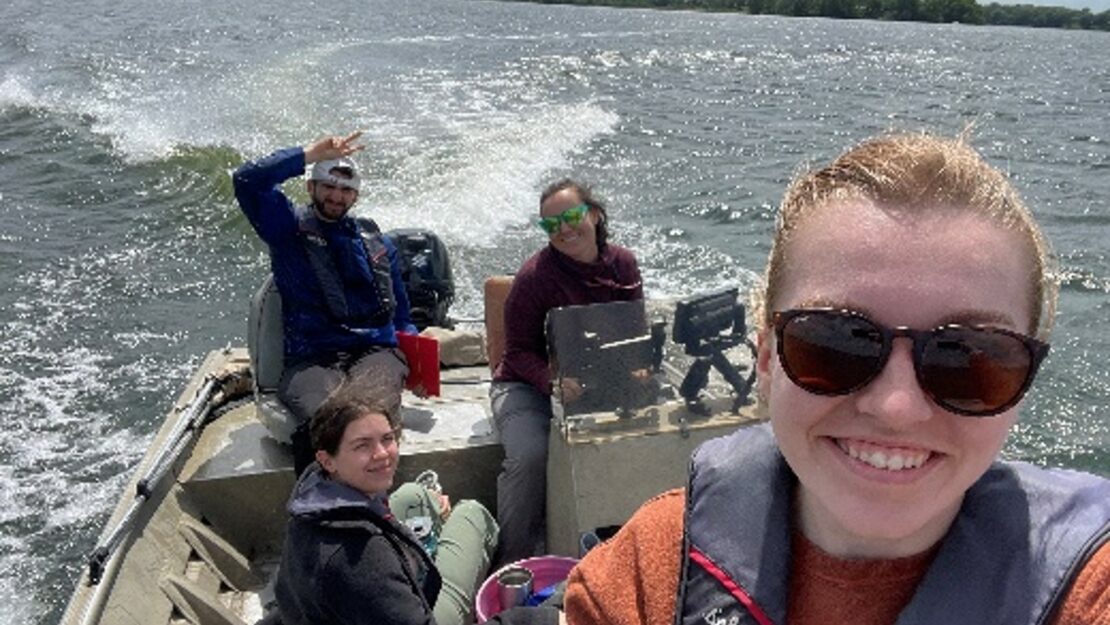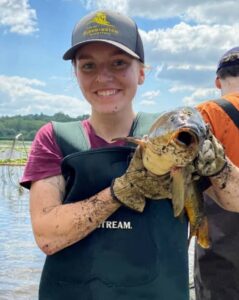Individual Placement Spotlight Series: Ava Schimnowski

By Jesse Wolk, Utility Mapping Specialist Individual Placement / AmeriCorps Member placed at Minnesota Department of Natural Resources, Division of Parks and Trails
V: Water
The Individual Placement (I.P.) Spotlight Blog is a series of interviews between Jesse Wolk and his fellow I.P. members with the goal of highlighting their unique positions, projects, and backgrounds while reflecting on their service term in the context of the Natural Resources career field. In the fifth edition of the series, Water, the spotlight is shifted to our Aquatic Management Specialist – Ava Schinmowski!
Before industrialization, on a social and individual level, our natural environment shaped who we were and what we did. Furthermore, every environment was defined by its resources. Accessibility of these resources, and how they were used, was the keystone of most cultures. If a culture had an abundance of a certain resource, it became core to their art, religion, and history. After industrialization and globalization, in the United States, this connection was largely lost. Today, most people don’t need to feel connected to their natural environment because anything in the world can be shipped to our doorstep. There is simply no need to be aware of what one’s immediate environment provides because we no longer provide most of the ingredients of what we consume. However, this awareness hasn’t completely died. In Minnesota, this is most embodied by its state-wide obsession for the one resource that has always reigned supreme: Water.
Minnesotan’s love their waterways. Since people have been able to live in the social boundary that we now call Minnesota, this has been the case. Our waterways developed civilizations long before the colonizers arrived and will support new ones long after the United States has disappeared. Unlike other resources within our state, see the annihilation of the prairie, our waterways have largely endured colonization and development. Today, not only the presence, but the abundance of our amazing, wonderful, freshwater is what makes this area truly unique. It is what we show-off to the world and our state flag now celebrates that sentiment. While many Minnesotans no longer seems to recognize the full scope of our natural heritage, everyone seems to still be aware of the rich resource that is our rivers and lakes.
As a byproduct of this shared cultural understanding, this resource has remained available to everyone. Unlike Minnesota’s land, by law, Minnesota’s water must be open and accessible to the public. In a unique instance of American equity, this resource cannot be owned privately. Instead, it is managed by federal, state, and local agencies who set policy for how people can alter, extract, and enjoy the resources within our lakes and rivers. However, where the water meets the land, there is some confusion on who can do what and how they can do it. Therefore, these agencies additionally set rules for how homeowners manage, “shoreland” property. I.P. member, Ava Schimnowski plays a key role in this process.

Ava’s first passion in conservation was developed after she took a Field Ecology class in high school. In that course, she said she developed an, “ecocentric” perspective of the earth through reflections that she did on her school’s woods and Aldo Leopold’s essential texts. She bopped around programs within the University of Minnesota Twin Cities, initially considering a major to prepare her for Genetic Counseling, but eventually settled on the Fisheries, Wildlife, and Conservation Biology program. This switch was solidified by Ava’s Field Technician experience with the Metropolitan Mosquito Control District, an agency that sits on the unique intersection of public health and wildlife biology.
Ava built on this experience and worked as a Water Resources Technician for the City of Bloomington. Ava says that this is when she decided that she wanted to work in managing water. She told me that her position was incredibly multifaceted, where she had experiences from collecting water samples to monitoring construction sites to planning out shoreline-buffer restoration projects. After one final fall semester, Ava found that the I.P. Program fit her current goals perfectly. She wanted a professional-developing water resources experience that would allow her to figure out her graduate school path, give her a needed break from school, and build a network with a government agency. She found her match.
Ava now serves in the Aquatic Plant Management Program for the Minnesota Department of Natural Resources as the I.P.’s Aquatic Plant Management Specialist. Her main task is to work with property owners who apply for a permit to remove aquatic vegetation from their shoreline. Landowners must go through the DNR via a permitting process to make sure that they are complying with this complicated regulation. A landowner will request a permit and someone like Ava will show up at their property to inspect their shoreline and determine the environmental impacts of their request. Ava takes pictures, takes measurements, completes aquatic plant surveys, addresses the landowner’s questions and concerns. Then she ships off her inspection materials to the main Aquatic Plant Management Specialist who makes the final permit decision.

When she isn’t busy assisting with completing inspections for the 100 backlogged permit applications in the Glenwood area, she is doing something quite similar, but different. Ava has been working with Conservation Easement specialists to ensure that these unique landowners are complying with their respective regulations. Again, Ava records what she sees and observes but this time is looking for any violations to an agreement that a landowner had with the DNR. Ava gets a unique opportunity to see the front and back-ends of the often-fraught bureaucratic conservation process through her own eyes and her professional counterpart’s.
Honestly, Ava’s position is amazing. Not only is her work very unique, she has also gotten to take a plethora of classes (AIS Core Detectors Course, Aquatic Plant ID Course, Prairie Plant ID Training, and an Aquatic Plant ID Review at Itasca State Park). She has also had unique professional development opportunities like shadowing an Invasive Species Specialist and got to collect Muskie milt with a Fisheries Specialist for one of the DNR’s many hatcheries. Through her independent work and shadowing experiences, she has also begun to overcome the imposter syndrome that is so common for many new graduates. For those who are currently feeling that way, Ava wants to emphasize that it is important to seek out new opportunities in these stepping stone jobs by reaching out to people you’re interested in working with, and not solely do what is assigned to you. Her next goal is to go to graduate school and get a Master’s Degree in Water Resources Sciences or Ecology with an ideal position as a Water Resources Specialist for a municipality or Watershed District.

Minnesota’s lakes and rivers are special. Every Minnesotan knows it and luckily, every Minnesotan has the right to them. Unfortunately, they are in a perilous place. One quarter of all lakes in Minnesota do not meet water quality standards due to excessive levels of algae caused by agricultural run-off. We are also just beginning to understand the extent to how much recently regulated plastic pollution has impacted our public health and safety. Additionally, our lakes are enduring a centuries barrage of invasive species that will alter our freshwater ecosystems, fisheries, and recreational opportunities. As climate change occurs, this will accelerate most of these issues so much that the resources that our freshwater systems provide may look unrecognizable. With regards to the state of our lakes and rivers, Minnesotan’s are facing a crisis.
As scary as this is, the first step is to acknowledge it. Our resources will change. With all of our pressing issues, it is inevitable. As a result, we will change how we use them. In turn, our self-identity will innovate itself to match those cultural shifts. However, the water will remain. Fortunately, we have people like Ava working hard to take the next step: To make sure that no matter what happens, our waters will be able to be enjoyed by future generations regardless of how different that looks.
Thanks for reading and catch you in a few weeks!
– Jesse Wolk